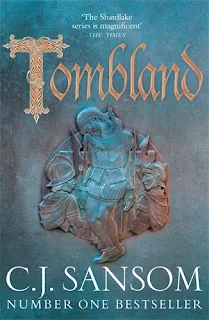Set in 1549, Tombland by C.J. Sansom is the 7th in the Matthew Shardlake series of historical fiction novels but can easily be read as a standalone. Shardlake is asked by the Lady Elizabeth (yep, the yet to be crowned Elizabeth I) to investigate the murder of a distant relative.
Matthew Shardlake is a hunchbacked lawyer and is investigating the murder with his assistant and friend when they're caught up in the peasant rebellion in Norwich. Being of the gentlemen class they're taken captive and need to use their wits to stay alive.
I didn't know anything about this country-wide peasant rebellion led by Robert Kett during the time of Edward VI, 2 years after the death of Henry VIII. I learned that the rebels sought to overthrow the landlords and address their unlawful and unjust practices and at the end of the novel, Sansom writes that it was a "colossal event that has been much underplayed." Page 806
Tombland is a chunkster of a book coming in at 866 pages, but with the last 66 pages containing an essay, acknowledgements, end notes and bibliography this was an enduring but rewarding book. The writing is excellent, the history and characterisation was top notch and I enjoyed the dialogue immensely. Here's an example:
"God's pestilence, lad, how on earth should I know? I have no idea." Page 34The cursing was amusing, with contributions like: "God's bones", "God's blood" and "shut your clack box." That one was so immediately evocative and amusing, it's stayed with me. Shardlake is a memorable character too, his condition and how it is perceived in the mid 1500s as well as how the lifestyle of the period impacts his health was infinitely interesting.
My advice? Don't let the size of Tombland by C.J. Sansom put you off picking this one up. It was a 5 star read for me the entire way and I came to think of it alongside the ilk of Ken Follett.
Highly recommended.
My rating = *****
Carpe Librum!




































Not sure about the title. cheers
ReplyDeleteHi Carole, the title Tombland is just the name of the suburb in Norwich where Shardlake stays for most of the time. So the title isn't anything creepy, although there are some graphic descriptions of hangings and the battle that take place. Not gratuitous, but used to evoke the reality of the time in history.
ReplyDelete